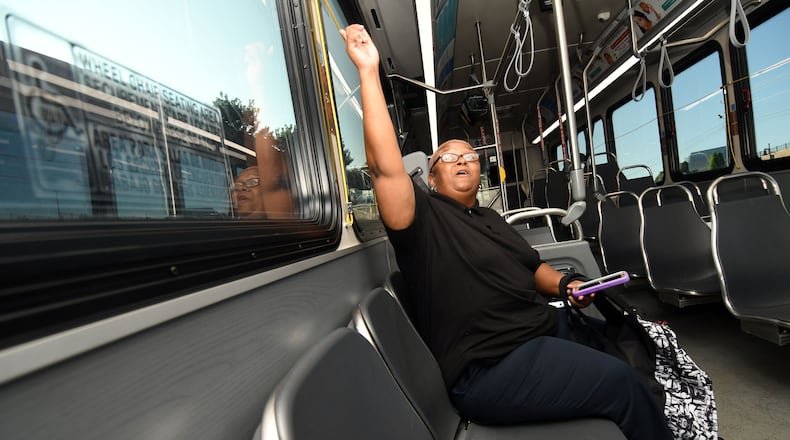Less than a year after launching it, Cobb County is contemplating cutting local bus service that it considered key to reducing traffic around the Atlanta Braves’ new stadium.
The Cumberland Circulator was sold to taxpayers as a vital piece of transit infrastructure that would ease congestion for the tens of thousands of people who not only attend games but work, visit and live in the Cumberland area throughout the year.
But the service is struggling to attract riders on non-game days, and residents and officials alike are starting to question whether the $1.2 million annual price tag is worth it.
Chairman Mike Boyce said this week that all money-saving options — including curtailing the bus service or cutting it altogether — are on the table after the Board of Commissioners rejected his proposed tax hike by a 3-2 vote last month.
“We have to look at everything,” Boyce said.
The circulator began operating with three routes on March 31 — the same day as the first exhibition game at SunTrust Park. Since then, more than 11,000 people have used it. A study conducted by an outside firm estimated the service would eventually draw between 80,000 and 133,000 passengers per year.
Transportation Director Jim Wilgus said circulator ridership is within projections for the first year, as new transit services typically take a few years to reach their full potential.
Oneichan Critchlow works as a dishwasher for a placement agency that often sends her to SunTrust Park. She enjoys it, despite the hour-and-a-half, three-bus commute from College Park where she lives.
On Sundays, when the circulator doesn’t run, Critchlow, who suffers from knee trouble at age 52, has to walk nearly two miles to the stadium from the Cumberland Transfer Center next to Cumberland Mall.
“If you had to do it every day, especially with leg problems, yeah, that would be bad,” she said. “I like the service. I hope they don’t stop it.”
One of the bus drivers, who declined to give his name because he was not authorized to speak to the press, said it was not uncommon for him to have just four riders over a ten-hour shift on non-game days.
The circulator was controversial from the start.
Critics saw it as another taxpayer-funded giveaway to the Braves, and questioned its necessity and funding. County officials insisted the stadium was merely the impetus to offer a much-needed local bus service in Cumberland and that it was needed to ensure safe pedestrian access.
Aside from SunTrust Park and The Battery, one of the largest convention centers in the southeast is located in the Cumberland area, in addition to major employers like Home Depot, Genuine Parts Company, GE Energy, Travelport and The Weather Company. More than 10,000 residents call the area home, with more apartments in development.
Selling the circulator as a regional traffic solution wasn’t just a matter of assuaging public anger over the Braves deal. It also allowed the county to access SPLOST funds to pay for two studies associated with the circulator at a cost of more than half a million dollars. The county payed another $670,000 for six buses.
Meanwhile, the “Cumberland Special Service District Hotel Circulator Fee” — a $3-a-night tax on hotel and motel rooms in the area that brings in about $3.6 million annually — has been dedicated to paying off the stadium debt service first, officials say. Officials will consider using only “excess” funds to pay for the circulator.
“The bulk of the circulator is funded through Transit in the General Fund,” said Wilgus, the transportation director.
Beth Marshall, spokeswoman for the Atlanta Braves, said the transportation plan for Cumberland was expected to evolve.
“We are confident that any adjustments made to the circulator will have very little impact on fans coming to our games or The Battery Atlanta,” she wrote in an email.
Tim Lee, former Cobb County Chairman and architect of the Braves deal, did not respond to messages. Faye DiMassimo, the former Cobb transportation director who now works for the city of Atlanta, referred questions back to the county.
In a survey taken before the service was launched, those who already used public transportation expressed overwhelming support for a circulator. But there were warnings ridership might not be as high as expected.
A Cumberland Mall representative doubted the service would be used by shoppers, and complained it was “intended primarily to serve the needs of the Braves” at the expense of those who live, work, shop and visit the area, according to a 2015 email obtained by The Atlanta Journal-Constitution.
Then, there was the Greater Cleveland Regional Transit Authority’s response to an email query from Cobb transportation officials about the Ohio city’s experience running a circulator.
“Unfortunately, although people ‘loved’ the circulators not many of them actually ‘rode’ the circulators,’” an authority representative wrote. “Needless to say, we are out of the circulator business.”
MYAJC.COM: REAL JOURNALISM. REAL LOCAL IMPACT.
The AJC's Meris Lutz keeps you updated on the latest happenings in Cobb County government and politics. You'll find more on myAJC.com, including these stories:
Never miss a minute of what's happening in Cobb politics. Subscribe to myAJC.com.
About the Author
Keep Reading
The Latest
Featured




